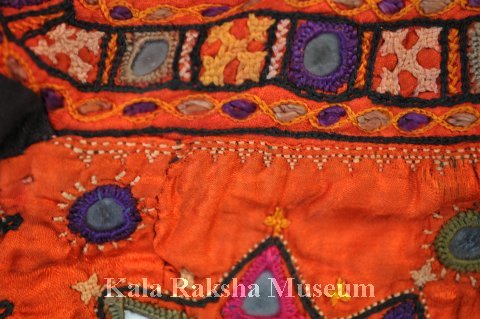|
Description
|
| MATERIALS: Silk & Cotton cloth, silk threads, mirrors. CONSTRUCTION: Hand stitched., embroidered : chain,interlaced, detached chain, Cretan, back, Romanian, doublebuttnhole, buttonhole filling stitches. MOTIFS: Borders:popti, limbudi tak, tak bavaliyo, kali tak jharmar, ghodi goto, goto, bajubandh. COLOURS : Multicoloured on orange and purple. STYLE REMARKS: Festival blouses are made on ''valuable cloth,'' whatever is currently fashionable. Silk was the original choice. However, threads were usually cotton. The traditional pattern of embelishment always included the baju bandh on the sleeve, goto at breasts and shoulders, and the kanchali na bandh on the belly. Some motifs, such as the latter, are used only for specific objects; thus they get such names. The latter motif was shifted to the neck in later styles. Style wastraditional up to 1950s. Ghodiyun and sandhiyo are optional. CULTYRAL SIGNIFICANCE: The backless blouse is worn by many communities of sindh, Rajasthan and Gujarat. It is cool in hot weather and economical to make. The back is covered by a veil. Gathered blouse is worn only by married women. CULTURAL REMARKS: The Kachhi version has shorter, fitted sleeves. Worn with a pachhedo [ghagharo for bride], and a ludi. Fitting remains constant, style of embroidery changes. Kanchali, Woman's blouse. |
Kanchali
-Rabari Arts
-Copyright Statement

COPYRIGHT INFORMATION ~ When using this image, the credit information should be in the following format: Image courtesy of the Kala Raksha Museum.

COPYRIGHT INFORMATION ~ When using this image, the credit information should be in the following format: Image courtesy of the Kala Raksha Museum.